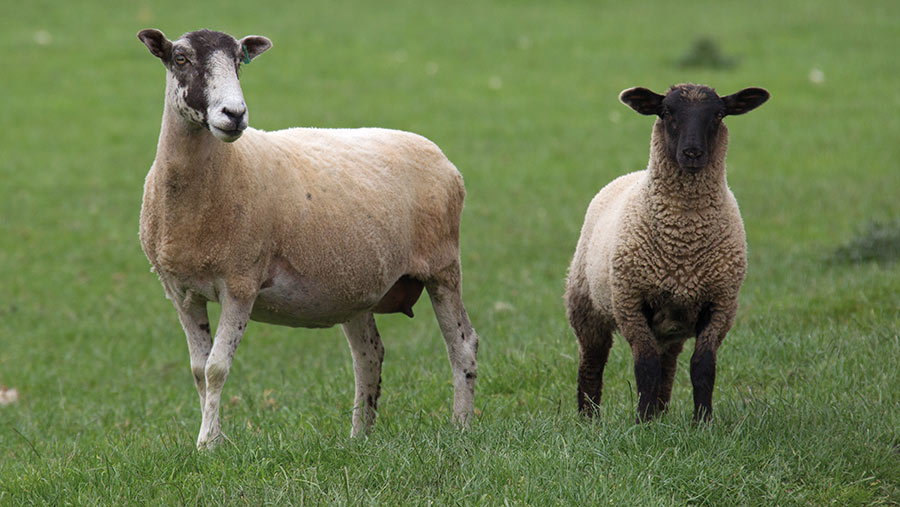Pasteurella vaccines: Common mistakes and how to avoid them
 © Tim Scrivener
© Tim Scrivener Pasteurellosis, also known as “enzootic pneumonia”, remains one of the most common causes of mortality in sheep of all ages. Despite its impact, the disease is still not wholly understood.
The bacteria responsible have been reclassified recently as Mannhemia haemolytica and Bibersteinia trehalosi.
Both are normal inhabitants of the nose and throat of healthy sheep.
See also: Sheep scab project to help hundreds of ‘hotspot’ farms
When sheep become stressed, however, these bacteria take a leap into the lower respiratory tract (lung), causing pneumonia and septicaemia. The most common sign is, unfortunately, sudden death.
Below, Kaz Strycharczyk, of Black Sheep Farm Health, explains what to look out for and how to prevent it through vaccination.
What stressors can cause pasteurellosis?
Stressors include poor, or sudden changes to, nutrition and weather. There is a recognised peak in the autumn, mirroring the most dramatic daily swings in temperature and humidity. Other diseases, such as fluke and worm burden, can weaken a sheep’s resilience to disease, too.
Social stresses such as transport and mixing can contribute to outbreaks. Even high growth rates can trigger pasteurellosis. Typically, it is the fittest lambs that succumb.
Is there any way of eliminating it from your flock?
The bacteria are found in all sheep, so there is no way of eliminating or eradicating it, nor a way of keeping it out through biosecurity.
So, what can be done?
Reducing losses involves limiting stress and building resilience through vaccination.
Vaccines against pasteurellosis are widely available, good value for money and commonly used, often in combination with vaccines against clostridial diseases such as pulpy kidney. As with most vaccines, protection is rarely 100%.
How should vaccination be carried out to ensure the best efficacy?
While their widespread use is commendable, there is still major room for increased uptake (see graph from AHDB, below).
There remain some common issues we see every year, which reduce the effectiveness of these vaccines. In turn, this leads to higher sheep mortality, with associated economic and animal welfare costs.
Although it may be unrealistic to expect zero deaths to pasteurellosis on even the best-managed farms, vaccination and careful husbandry will reduce them to a fraction of their potential.
Here are some tips to try and overcome potential problems often seen when vaccination is carried out on farm:
- Make sure lambs are protected early enough. Assuming ewes are boosted four to six weeks pre-lambing, lambs receive protection through their mother’s colostrum. But this cover only lasts about three weeks. Vaccines are licensed for use from three weeks of age, so once lambs are batched, don’t delay vaccinating them.
- For maximum effectiveness, use the schedule, dose and route of administration (usually under the skin) recommended by the manufacturer. If you’re unsure, check the datasheet, which can be found in the box. If you’re still unsure, ask your vet.
- Oil-based vaccines often elicit a potent reaction under the skin. To avoid abscesses, ensure all injection equipment is thoroughly cleaned. Your best bet is to clean it immediately after use. Wash only with ample warm water; don’t use soap or disinfectant. Use a dedicated gun for each type of vaccine.
- Change needles regularly. How often depends exactly on wear and tear, as well as the type of needle. If in doubt, ask your vet. Any needle that is dropped, visibly dirty, bent or blunt should be changed immediately.
- As with all vaccines, maintain a chilled environment (2-8C) at all stages (in transit, before use and during use). Once vaccines warm up, they are useless, unless used immediately. Don’t underestimate how quickly bottles of vaccine warm up to ambient temperature, especially on the dashboard of a pickup. Cool boxes are cost-effective and readily available.
- Don’t open vaccine bottles and then use them the following day. Buying more bottles with fewer doses can easily be worth the small added cost.
- Once replacement ewe lambs have had their primary course, don’t forget to give them a booster with the breeding ewes pre-lambing in their first year. They are easily forgotten at this point.
- An autumn booster may be advisable on some farms if deaths still persist with an annual booster.
Husbandry tips to limit losses
- Consider potential stresses and take steps to reduce them. The weather may not be within our control, but we have great influence over concurrent disease, nutrition and husbandry.
- Investigate sudden deaths. Pasteurellosis is a very common culprit, but it is not the only candidate. Clostridial disease and plant poisoning are two other plausible causes, for example. Once you know what is causing mortality, you can put specific preventative measures in place.
Each month, we bring practical independent advice from an XLVets practice on a range of different subjects.
